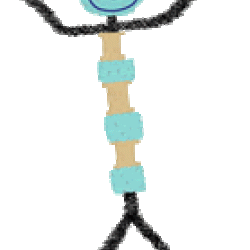Source Institutions
Source Institutions
Add to list Go to activity
Activity link broken? See if it's at the internet archive

In this activity, learners simulate what happens to a human spine in space by making Sponge Spool Spines (alternating sponge pieces and spools threaded on a pipe cleaner). This represents a human spine on Earth, with the discs (sponges) pressed between the spinal vertebrae (the wooden spools). Learners measure the spine length, dip it in a glass of water (simulating microgravity), and then re-measure the spine. They will find it has expanded, just like in space! This activity station is part of a sequence of stations that can be set up to help learners explore how space affects the human body and why.
- 10 to 30 minutes
- 10 to 30 minutes
- $5 - $10 per group of students
- Ages 8 - 14
- Activity, Lesson/Lesson Plan, Model
- English
Quick Guide
Materials List (per group of students)
- A tall, clear (not translucent) container filled ¾ full with water (a clear 2-liter soda bottle with the top few inches cut off works well)
- A ruler
- 1 pencil (slightly sharpened)
- Scratch paper and writing utensils
- Children's Guide for Sponge Spool Spine
- Pipe cleaners
- Small wooden spools
- Sponge cut-outs, about the size of a dime
- Circular sponges cut-out about the size of a half-dollar for a Sponge Spool Spine head (optional)
Subjects
-
Earth and Space Science
- Astronomy
- Solar System
-
Life Sciences
-
Human Body
- Skeleton
- Health and Nutrition
-
Human Body
-
Mathematics
- Measurement
-
Physical Sciences
-
Motion and Forces
- Gravity
-
States of Matter
- Liquids
-
Motion and Forces
-
The Nature of Science
-
The Scientific Process
- Conducting Investigations
- Gathering Data
- Formulating Explanations
- Communicating Results
- Science as a Career
-
The Scientific Process
Informal Categories
- Arts and Crafts
- Model Building
Audience
To use this activity, learners need to:
- see
- read
- touch
Learning styles supported:
- Involves hands-on or lab activities
Other
Components that are part of this resource:
Includes alignment to state and/or national standards:
This resource is part of:
- Lunar and Planetary Institute Educator Resources
- Explore! Health in Space
- Space Stations - Living and Working in Space (activity series)
Access Rights:
- Free access
By:
- Department of Education and Public Outreach, Lunar and Planetary Institute; Byerly, Dr. Diane
Rights:
- All rights reserved, Lunar and Planetary Institute, 2006
Funding Source:
- NASA's Exploration Systems Mission Directorate's Education Program
